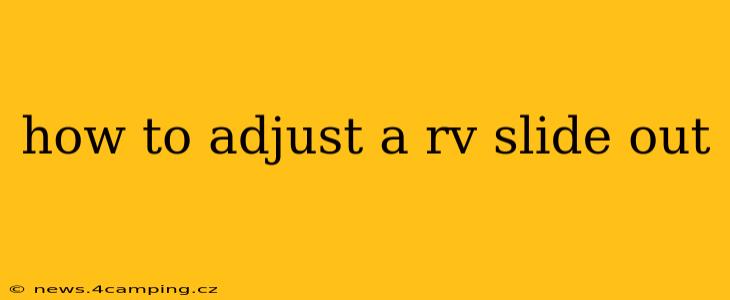RV slide-outs are a fantastic feature, adding significant living space to your camper. However, over time, they can become misaligned, leading to sticking, binding, or even damage. This guide will walk you through how to adjust your RV slide-out, addressing common problems and preventative maintenance. Remember, safety first! Always disconnect power and engage the slide-out's locking mechanism before performing any adjustments.
Why is My RV Slide-Out Misaligned?
Several factors can cause slide-out misalignment. These include:
- Normal wear and tear: Repeated use causes components to loosen or wear down.
- Uneven ground: Parking on uneven surfaces can stress the slide-out mechanism.
- Impact damage: Accidental bumps or collisions can easily throw the system out of alignment.
- Improper lubrication: Lack of lubrication increases friction and wear.
- Loose or damaged components: Over time, screws, bolts, and other parts can loosen or become damaged.
How to Diagnose Slide-Out Problems
Before you begin adjustments, it's crucial to identify the specific issue:
- Binding or sticking: This often indicates a problem with the rollers, tracks, or alignment.
- Dragging or scraping: This usually means the slide-out is not tracking properly.
- Uneven extension: If the slide-out extends unevenly, this points towards alignment issues.
- Noisy operation: Grinding or squeaking sounds usually indicate a lack of lubrication or worn components.
Adjusting Your RV Slide-Out: A Step-by-Step Guide
This process generally involves adjusting the rollers, which are responsible for the smooth movement of the slide-out. The specific location and adjustment methods will vary depending on your RV's manufacturer and slide-out system. Consult your RV's owner's manual for detailed diagrams and instructions specific to your model.
Caution: Improper adjustments can worsen the problem. If you're uncomfortable working on your slide-out, it's best to seek professional help from an RV mechanic.
1. Accessing the Slide-Out Mechanism
This usually requires locating access panels either inside or outside the RV, near the slide-out's frame.
2. Identifying Adjustment Points
Look for adjustment screws or bolts on the rollers. These are typically used to fine-tune the slide-out's vertical and horizontal position.
3. Making Adjustments
- Small adjustments are key: Turn the adjustment screws or bolts in small increments, testing the slide-out's movement after each adjustment.
- Vertical adjustment: Adjust screws to raise or lower the slide-out.
- Horizontal adjustment: Adjust screws to move the slide-out left or right.
- Testing: Extend and retract the slide-out repeatedly to test the adjustments.
What if I Can't Find Adjustment Points?
Some RV slide-out systems may have different adjustment mechanisms. In this case, you may need to:
- Consult your RV's owner's manual: It should provide detailed information about your specific slide-out system.
- Contact the RV manufacturer: They can provide instructions or refer you to a qualified service technician.
- Seek professional help: An RV mechanic will have the expertise and tools to diagnose and fix the problem.
Lubrication: Preventative Maintenance
Regular lubrication is crucial for preventing slide-out problems. Use a high-quality lubricant specifically designed for RV slide-outs. Apply lubricant to the rollers, tracks, and other moving parts according to the manufacturer's instructions.
How Often Should I Lubricate My RV Slide-Out?
Lubricating your slide-out every 3-6 months, or more frequently if you use it extensively, is recommended for optimal performance.
Troubleshooting Common Problems
H2: My slide-out is binding or sticking.
This often indicates a problem with the rollers, tracks, or alignment. Check for debris in the tracks, and lubricate the moving parts. If the problem persists, you may need to adjust the rollers.
H2: My slide-out is extending unevenly.
This is an alignment issue. Adjust the rollers to bring the slide-out into proper alignment.
H2: My slide-out is making noise.
This could be due to a lack of lubrication or worn components. Lubricate the moving parts. If the noise persists, you may need to replace worn components.
H2: What are the signs of a serious slide-out problem?
Serious problems include significant binding, damage to the tracks or rollers, or the slide-out becoming completely jammed. In these cases, immediate professional help is required.
By following these steps and regularly performing preventative maintenance, you can keep your RV slide-out functioning smoothly for years to come. Remember, if you are uncertain about any step, consult a professional RV technician. Your safety and the longevity of your RV are paramount.
